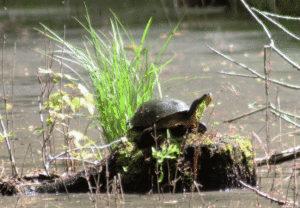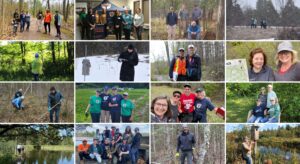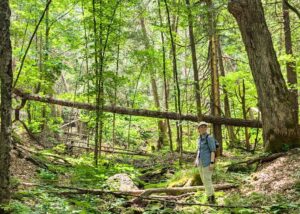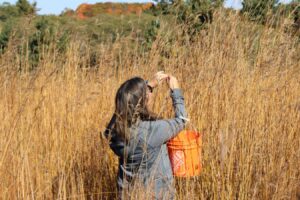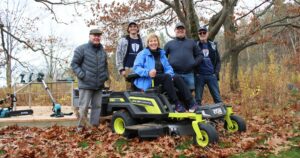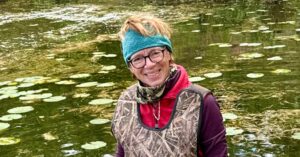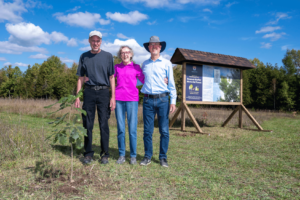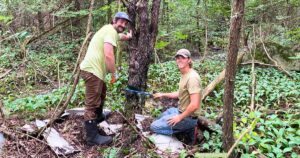For the past 20 years, Kawartha Land Trust (KLT) and its dedicated supporters have protected ecologically significant land in the Kawarthas to help preserve the natural landscape and conserve the rich biodiversity of the region.
KLT’s work in land securement and land stewardship protects species at risk in the area by ensuring the preservation of important habitats like wetlands and forests with vernal pools that support species that are experiencing declining populations due to encroaching development and climate change.
Species at risk is an official species classification that identifies species as endangered, threatened, special concern or extirpated (extinct).
In the last year, KLT has supported habitat for three species at risk that are valuable to the Kawarthas and are the target of federal recovery initiatives.
Eastern Whip-poor-will (Antrostomus vociferus)
Conspicuous by day, but an audible delight at night, the eastern whip-poor-will is an incredible aerial hunter and grassland specialist bird. It is fully nocturnal and is most active around dawn and dusk when it flies from perches to snag insects out of the air in its impressively large mouth. On bright nights it may hunt by moonlight. When not hunting, males call from select perches in their territories with a long and continuous string of “whip! POOR wiiiillll” for hours at a time.
For ideal hunting and nesting conditions as females lay camouflage eggs directly on the forest floor, the eastern whip-poor-will prefers open meadows, barrens and grasslands bordered by tall trees with little understory vegetation.
Eastern whip-poor-wills are listed as a species at risk in Ontario due to habitat loss and a decline of insects, which makes the protection of their habitat paramount in preserving this species and its charming call for generations to come.
Through the restoration of habitat near Bethany and the permanent protection of land, Kawartha Land Trust has created hospitable habitat for this species. To further our conservation efforts, KLT has engaged neighbours surrounding our nature preserves to educate them about this species. We have also documented species observations so that scientists understand the distribution of the species in the region.
Blanding’s Turtle (Emydoidea blandingii)
A vibrant flash of yellow in the wetlands across central Ontario, the Blanding’s turtle is a specialist of slow-moving water bodies but is no stranger to travel. Recognized by its unmistakable bright yellow throat and high, domed shell, this species is often seen basking on logs or floating mats of vegetation. It is also encountered on roadsides where females take advantage of the sandy soils to lay eggs.
Despite the aquatic reputation of most turtles, this species is known to travel several kilometres over land to find good nesting sites or habitats. Due to the effects of habitat fragmentation and high rates of mortality experienced by this species attempting to cross roads, the Blanding’s turtle is listed as a species at risk in Ontario.
Road crossing structures can help this species avoid the impact of vehicles, however, the biggest positive impact we can have is protecting wetlands in large and unfragmented swaths for Blanding’s turtles and many other species to enjoy.
Several Kawartha Land Trust properties contain critical wetlands and upland habitats for this sensitive species.
Western Chorus Frog (Pseudacris triseriata)
When we think of frogs in Ontario we often think of lily pad-basking amphibians in a tranquil pond, but the province also boasts three species of tree frog, including the western chorus frog.
Despite being relatively small at four centimetres long, this species has a huge presence in early spring when males call in large groups. They do so in temporary bodies of water called vernal pools, on roadsides, in fields and forests and in isolated wetlands. Their distinct “creee-eee-eek” callis similar to the sound made when running your finger over the teeth of a comb and is often heard in concert with spring peepers and wood frogs.
Western chorus frogs are a species at risk and rely on continuous habitat. Populations can be entirely cut off from each other by a simple two-lane road, which makes the protection of their habitat critical to preserving this arboreal amphibian.
In 2021, Kawartha Land Trust partnered with citizen scientists to understand the distribution of this species on and around our properties. We protected critical habitats for the species by limiting disturbance to their habitats on our reserves.
Interactive Species at Risk Map
Take a moment to explore Kawartha Land Trust’s new interactive map to learn more about the species at risk that KLT properties protect and the type of habitats that support their populations in the Kawarthas.
Fight Against Biodiversity Decline Wish to learn more about how you can fight against biodiversity decline in Ontario? Visit Ontario’s “Conserving Biodiversity” web page to learn how you can protect the province’s most vulnerable plants and animals. You can also volunteer with Kawartha Land Trust to help support our work in protecting the land you love.
Together, we can ensure species at risk like chorus frogs, grasshopper sparrows and monarch butterflies continue to have a home in the Kawarthas.
March 30, 2022. Photo: A Blanding’s turtle, a species at risk in Ontario, basking on a tree stump in a marsh. Credit: Veronica Price-Jones.
This project was undertaken with the financial support of:
Ce projet a été réalisé avec l’appui financier de:
![]()

